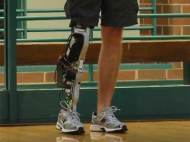Smart lower-limb prosthetic enables amputees to walk with less effort
 Researchers from the Vanderbilt University developed a prosthetic with powered knee and ankle joints that operate in unison, thus allowing its wearers to walk without the leg-dragging gait characteristic of conventional artificial legs. The bionic leg is programmed to use the motion data in order to predict what the person is trying to do and operate the device in ways that are suited to these movements.
Researchers from the Vanderbilt University developed a prosthetic with powered knee and ankle joints that operate in unison, thus allowing its wearers to walk without the leg-dragging gait characteristic of conventional artificial legs. The bionic leg is programmed to use the motion data in order to predict what the person is trying to do and operate the device in ways that are suited to these movements.
The prosthesis is the result of a seven-year research effort at the Vanderbilt Center for Intelligent Mechatronics, and it is designed for daily life. It weights only 4kg (about 9 pounds), and it can operate for three days of normal activity on a single charge. In comparison, the prosthesis can operate for around 13 kilometers (a bit more than 8 miles) of continuous walking.
“With our latest model, we have validated our hypothesis that the right technology was available to make a lower-limb prosthetic with powered knee and ankle joints”, said Michael Goldfarb, the H. Fort Flowers Professor of Mechanical Engineering at the Vanderbilt University who directed the development. “Our device illustrates the progress we are making at integrating man and machine.”
One of the latest capabilities that the engineers have added is an anti-stumble routine. If the leg senses that its user is starting to stumble, it will lift up the leg to clear any obstruction and plant the foot on the floor.
Aside developing a control system used to control bionic leg behavior in various situations, the researchers had problems with weight of the prosthesis and the noise it made. The powerful motors and drive train needed to fit into the available volume of the limb and be light enough for the user to wear them. The latest model is significantly quieter compared to previous models, but it is slightly louder than they would like.
The control system and lower weight enable a lower-limb amputee to perform daily tasks such as walking, standing, and going up and down stairs and ramps, with greater ease compared to passive lower-limb prosthetics.
“Going up and down slopes is one of the hardest things to do with a conventional leg”, said Craig Hutto, 23-year-old amputee who has been testing the leg for several years. “So I have to be conscious of where I go because I can get very tired walking up and down slopes. But that won’t be a problem with the powered leg because it goes up and down slopes almost like a natural leg.”
Studies have shown that people who use the device employ 30 to 40 percent less of their own energy to operate the prosthesis, and that users of the new lower-limb prosthesis walking on level surfaces manage to walk 25 percent faster compared to users with passive lower-limb prosthetics.
Key aspects of the design have been patented by the university, which has granted exclusive rights to develop the prosthesis to Freedom Innovations, a developer and manufacturer of lower limb prosthetic devices.









to whom it may concern
I’m seeking a bionic lower limb prosthesis for my sister. She had a traffic accident and left lower limb amputated. I’d like to know detailed information which kind of prosthesis will be suitable for us and which steps will required to gain these kind of products. Personal social sequrity will support all expenses so the cost is not important than the my sister’s life quality.
I’m expecting for your quick reply.
Yours
Ferhat
I am a recent lower leg amputee and would like any info on volunteering for testing of “bionic” lower limbs.
Thank you, Alan J. Dziuk.
author
@Ferhat: I’m sorry for late reply, somehow I missed the comment when you wrote it.
You can find the needed contact information for distributors around the world on this page.
@Alan: You can check the pages of suggested associations and communities for any fresh news here.
I have a right lower leg amputation as of 2018 ,I have the basic set-up with rigid ankle . I was a drummer since age 9,and played pro. for many years. I would love the chance to volunteer for any hydraulic system or smart leg system. Thank you…